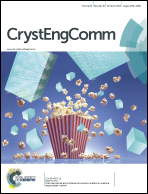Polymorphism and isomorphism of Huperzine A solvates: structure, properties and form transformation†
Abstract
Huperzine A is a naturally occurring alkaloid used in clinical treatments for Alzheimer disease. The drug has also been widely used in dietary supplements for improving memory loss and mental impairment. There are three polymorphs and a monohydrate form reported in the literature. In present work, single crystal structures of a new polymorphic monohydrate and four organic solvates were described. The study of single crystal structures of solvates was used as an example to illustrate the formation of different, yet reoccurring packing patterns depending on the inclusion solvent structures. The physicochemical properties of each solvate were examined by a variety of analytical techniques, including PXRD, Raman, IR, DSC, TGA and DVS etc. Form transformation between solvates and hydrates and desolvation processes were studied by DVS isotherms and slurry experiments. The packing efficiency of various solid-state forms, including three pure polymorphs and six solvates crystals were also compared and the results were correlated with their thermo stabilities.


 Please wait while we load your content...
Please wait while we load your content...